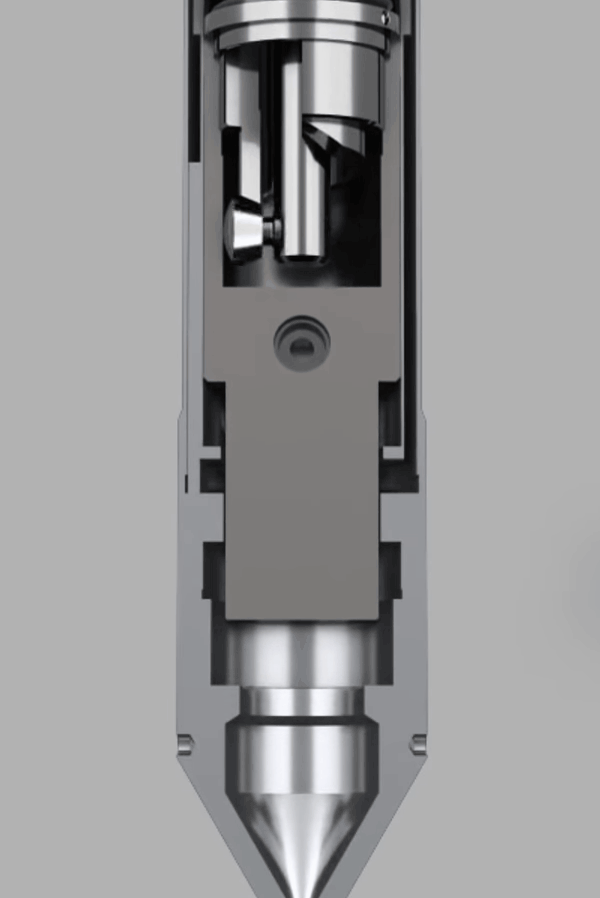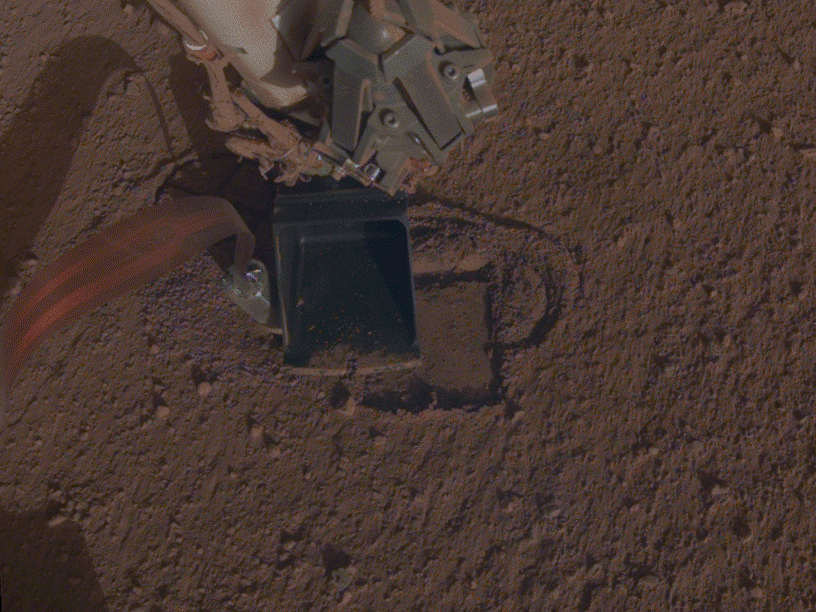Your job might be tough, but spare a thought for any of the engineers involved in the Mars InSight lander mission when they learned that one of the flagship instruments aboard the lander, indeed the very instrument for which the entire mission was named, appeared to be a dud. That’s a bad day at work by anyone’s standards, and it happened over the summer when it was reported that the Mars Interior Exploration using Seismic Investigations, Geodesy and Heat Transport lander’s Heat Flow and Physical Properties Package (HP³), commonly known as “The Mole”, was not drilling itself into the Martian regolith as planned.
But now, after months of brainstorming and painstaking testing on Earth and on Mars, it looks as if the mole is working again. NASA has announced that, with a little help from the lander’s backhoe bucket, the HP³ penetrator has dug itself 2 cm into the soil. It’s a far cry from the 5-meter planned depth for its heat-transfer experiments, but it’s progress, and the clever hack that got the probe that far might just go on to salvage a huge chunk of the science planned for the $828 million program.
Mars is Weird

When the mole first started having problems, it seemed like it had suffered the fate of any terrestrial ditch digger who has sunk a shovel into the ground where glaciers have once visited: it hit a rock. But the landing site for InSight was specifically chosen to be as rock-free as possible, based on data from earlier missions. NASA and JPL felt that the chance of hitting a subsurface rock was as low as 4%, and indeed telemetry coming back from the penetrator and the seismic instruments deployed by InSight seemed to argue against a physical obstruction.
After diving into the data, it became clear that the problem boils down to a simple fact: Mars is weird. More specifically, the Martian regolith did not have the physical characteristics that the scientists expected. The penetrator works a bit like an impact drill; an electric motor rotates a cam that retracts a hammer up against a powerful loading spring. When the cam releases, the hammer blasts forward under spring pressure. The net force is downward because of a second damper spring in the penetrator, but also because of the friction between the penetrator’s hull and the regolith. And therein, apparently, lies the problem: the material properties of the regolith is not at all what scientists expected.
Might as Well Be Rock
Images from the camera on InSight’s robot arm showed that the initial period of hammering into the regolith only succeded in reaming out a large, cone-shaped divot, leaving the mole akilter and without anything to push against. What’s more, the camera was able to peer into the hole and see a layer of duricrust, a geological term for a thin, hard layer of soil near the surface, caused when minerals dissolved in subsurface water precipitate and cement the soil particles together. Scientists knew that duricrust exists on Mars; indeed, it’s one of the main pieces of evidence that liquid water once existed there. But they didn’t expect that they’d encounter it at the InSight landing site.
With a hard layer holding things up and a complete lack of friction to work against, engineers came up with a couple of ideas for recovery. The robotic arm with its backhoe-like scoop was used to push around the perimeter of the divot, in the hopes that it would collapse the regolith back into the hole and provide some friction. Seven attempts at an induced cave-in failed, partly because the HP³ experiment has been set up as far from the lander as possible. This means the robot arm is extended to almost its full travel, and the force it can exert on the regolith is much reduced.
Pinning Down the Problem
Plan B involved gingerly pinning the mole to the side of the hole with the bucket. The potential for disaster here was high given the lag between sending commands to Mars and getting the data back. The bucket could easily damage the mole, especially at the vulnerable connection between the hull and the long Kapton tail containing power and data for the penetrator as well as the soil sensors.
After ample testing, pinning was determined to be safe enough to try, and in conjunction with using the scoop to drag material into the divot, the combined friction was enough to give the mole the bite it needed to start making progress through the duricrust.
It remains to be seen how well this works in the long run, and what happens once the mole is beyond the helpful reach of the robotic arm. It’s also not clear that the probe will make it all the way through the duricrust, which could be anywhere from millimeters to meters thick, without further assistance. The team is looking at ways to use the bucket to push directly on the back of the penetrator if the duricrust layer proves difficult to work through.
That will be as dicey an operation as any performed in space before, and such a move would likely be a last-ditch effort as it may well cost the HP³ package its life. But at least the InSight team still has some options, and is finally showing progress on a tough set of problems.


















And now it actually pushed itself out of the whole.
Just saw that in my news feed. Dang!
So, what you’re saying is that the probe is having difficulty penetrating the fertile soil.
TBF penetrating for the first time is usually harder.
“last-ditch effort”. I dig that joke, lol
It could be very deep, but that joke was a little shallow.
Also, that instrument was made by polish team and we have good adage for this: “Kto pod kim dołki kopie, ten sam w nie wpada” (who makes holes under someone, falls in himself).
Looks like the Polish team didn’t polish their instrument enough
:o)
Maybe it would dig better if it was mounted on a pole… ]:->
As I understand, it has TOO LITTLE friction, not too much. :-)
Maybe that’s the source of the Minecraft adage: “Never dig straight down.”
“Mole eat Mars”. Mars Incorporated dig that joke, lol
:o)
Going to the Nasa site … It appears it has now backed itself half way out! Maybe the gopher down below pushed it back out :) . They are evaluating :) .
Monday morning quarterback here.
Why didn’t they just use a proper auger bit and motor?
Too easy. They had to spend those millions somehow …
An auger requires a rather heavy well supported base to provide a counter torque, the often witnessed failure mode of hand held augers is to jam and spin the user around the tool, not what you want to happen to your light expensive lander. Also an auger can only dig as deep as the shaft and has to be raise and lowered to clear material, this again would require a much more robust machine, which is larger, has more elements that could fail, and costs much more money.
Bottom line they were trying to make a very small and light machine that could ride along with the lander and dig deeper than it is long, not an easy thing to design, especially when you are mostly guessing on the material properties of what it is going to be digging through.
Having said that, I think an auger style attachment to the rear of the probe would have been a great idea, allowing the probe to alternate digging styles and providing a stronger back force (vs relying on friction against a smooth surface) to push against. This would keep it from pushing itself backwards, which is what the current probe did.
I think the self-digging impactor is a valid idea, but I wonder why they didn’t include some sort of friction material or appendage. Seems like even if the testing on simulated regolith showed the stock mole working as planned, it would have been cheap insurance to just wrap the thing in skateboard tape (OK, space-rated skateboard tape) or even to include deployable wedges or barbs along the hull, just in case it ran into a friction issue.
Maybe they found it worked better in simulated martian soil at 5m under surface, where your martian dust could clog rotating joints. Then they didn’t check if it will work with reduced gravity (like on mars) because no one wanted to fund anti gravity simulator.
https://apod.nasa.gov/apod/image/1910/ClayCache_Curiosity_9990.jpg
:o)
is there a reason why they don’t dig through the crust with the scoop first?
NASA deploys a thumper on Mars. No sandworms seen yet.
The spice must flow.
What? No Plan B? How tuff would it have been to add a simple rod and knob, like a double headed nail, on the top of the mole so that the scoop, with a notch, could lift the mole, find a new spot and restart the process.
The mole, being of a very clever design is a bad one for this job. They may as well have gone to the local sex toy shop, buy the fanciest marital aid, put a temperature probe in it and sent it to Mars.
The wire that is attached to the mole seems very fragile and vulnerable. Just a few too many twists or if it is bent a few too many times, it is mission over.
While we are at it, who came up with the idea of that grapple? Did they run out of motors? Is automotive thermostat technology the only thing they could come up with?
If I were going to drill a hole into a planet with unknown properties, I would pay for the extra weight and send a real drill, like a hammer drill with a long hollow drill bit that is NOT open at the end. Once the drill is all the down then feed the temperature probe (like a two wire thermocouple) down to the bottom. Even if you only go down 4 feet that is far better than the current result of only a few inches.
Think about it, we want to drill a hole into something like layers and layers of clay flower pot like material with maybe some layers in between of loose sand or packed regolith, and oh yes, a few rocks. And to all of that let’s add some water, frozen or liquid. Did anyone try this out in salty mud?
Once the mole starts to go at an angle, then just like a nail, your only choice is to pull it out and start a new hole. Woops! Oh, that’s right, we have got no way to retry this! Try as you might, I am afraid this part of the mission is over.